Short Answers
Q.1. When you lift a box from the floor and put it on an almirah the potential energy of the box increases, but there is no change in its kinetic energy. Is it a violation of conservation of energy?
No. Work done in lifting the box increases the potential energy of the box. During lifting at every point, the force applied by us on the box in the upward direction is equal to the gravitational force acting on the box in the downward direction. Therefore, there is no change in the velocity of the box. As a result, the kinetic energy of the box will not change.
Q.2. A particle is released from the top of an incline of height h. Does the kinetic energy of the particle at the bottom of the incline depend on the angle of incline? Do you need any more information to answer this question in Yes or No?
No, the kinetic energy of the particle at the bottom of the inclined plane does not depend on the angle of inclination. When the particle reaches the ground, all its potential energy, while at the top of the inclined plane, is converted into kinetic energy. As we know that kinetic energy depends only on the height of the particle, it will be the same for different angles of inclination.
No, we do not need any other information to answer this question.
Q.3. Can the work by kinetic friction on an object be positive? Zero?
Yes. Let us consider a block A which is resting on another block B. Block B is resting on a smooth horizontal surface. Let the coefficient of friction between the blocks be μ.

When a force F is applied on block B in the forward direction as shown in the above figure, block A moves with block B in the direction of the applied force. The frictional force on block A and the displacement will be in the forward direction. Therefore, work done by the frictional force is positive.
If we consider the reference frame of block B, then displacement of block A will be zero. Therefore, work done by the frictional force is zero.
Q.4. Can static friction do nonzero work on an object? If yes, give an example. If no, give reason.
Yes. Let us consider a block A which is resting on another block B. Block B is resting on a smooth horizontal surface. Let the coefficient of kinetic friction between the blocks be μk.
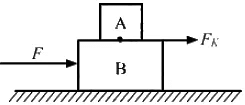
When a force F is applied on block B in the forward direction as shown in the above figure, block A moves with block B in the direction of the applied force. The friction force on block A and the displacement will be in the forward direction. Therefore, work done by the friction force is positive. In this case, block A will remain in contact with block B. This shows that static friction is doing a nonzero work on an object.
Q.5. Can normal force do nonzero work on an object? If yes, give an example. If no, give reason.
Yes. Let us consider an elevator accelerating upward with a body placed in it. In this case, the normal reaction offered by the floor of the elevator on the body is greater than the weight of the body acting in the downward direction. If a person is observing this from the ground, then, for him, the normal reaction is doing a positive work, as the elevator is moving upward.
Q.6. Can kinetic energy of a system be increased without applying any external force on the system?
Yes. Let us consider an isolated system of two particles falling towards each other under their mutual gravitational force of attraction. Here, the net force on the system is zero, but the velocities of the particles keep on increasing. Also, the kinetic energy of the system is increased without applying any external force on it.
Q.7. Is work-energy theorem valid in non-inertial frames?
In an non-inertial frame, pseudo force also comes into account. As we know that pseudo force does not exist, work-energy theorem is not valid in non-inertial frames.
Q.8. A heavy box is kept on a smooth inclined plane and is pushed up by a force F acting parallel to the plane. Does the work done by the force F as the box goes from A to B depend on how fast the box was moving at A and B? Does the work by the force of gravity depend on this?
(i) No. As the surface is smooth and the friction is zero, work done by the force will only depend on the force and the displacement.
(ii) No, because gravitational force is a conservative force and work done by a conservative force will depend only on the force and the displacement
Q.9. One person says that the potential energy of a particular book kept in an almirah is 20 J and the other says it is 30 J. One of them necessarily wrong?
No, both are correct. We measure potential energy from a reference level chosen by the observer. Therefore, in this case, both observers are measuring the potential energy from different reference levels.
Q.10. A book is lifted from the floor and is kept in an almirah. One person says that the potential energy of the book is increased by 20 J and the other says it is increased by 30 J. Is one of them necessarily wrong?
Yes, one of them is necessarily wrong. We measure potential energy from a reference level chosen by the observer. However, the change in potential energy of a body does not depend on the level of reference.
Q.11. In one of the exercises to strengthen the wrist and fingers, a person squeezes and releases a soft rubber ball. Is the work done on the ball positive, negative or zero during compression? During expansion?
(i) During compression, the work done on the ball is positive as the direction of the force applied by the fingers is along the compression of the ball.
(ii) During expansion, the work done is negative as expansion takes place against the force applied by the fingers on the ball.
Q.12. In tug of war, the team that exerts a larger tangential force on the ground wins. Consider the period in which a team is dragging the opposite team by applying a larger tangential force on the ground. List which of the following works are positive, which are negative and which are zero?
(a) work by the winning team on the losing team
(b) work by the losing team on the winning team
(c) work by the ground on the winning team
(d) work by the ground on the losing team
(e) total external work on the two teams.
(a) Work by the winning team on the losing team is positive, as the displacement of the losing team is along the force applied by the winning team.
(b) Work by the losing team on the winning team is negative, as the displacement of the winning team is opposite to the force applied by losing team.
(c) Work by the ground on the winning team is positive.
(d) Work by the ground on the losing team is negative.
(e) Total external work on the two teams is positive.
Q.13. When an apple falls from a tree what happens to its gravitational potential energy just as it reaches the ground? After it strikes the ground?
When an apple falls from a tree, its gravitational potential energy decreases as it reaches the ground. After it strikes the ground, its potential energy will remain unchanged.
Q.14. When you push your bicycle up on an inclined plane, the potential energy of the bicycle and yourself increases. Where does this energy come from?
When a person pushes his bicycle up on an inclined plane, the potential energies of the bicycle and the person increase because moving up on the inclined plane the kinetic energy decreases. and as mechanical energy is sum of kinetic energy and potential energy, and remains constant for a conservative system. Therefore, potential energy must increase in this case.
Q.15. The magnetic force on a charged particle is always perpendicular to its velocity. Can the magnetic force change the velocity of the particles? Speed of the particle?
The magnetic force on a charged particle is always perpendicular to its velocity. Therefore, the work done by the magnetic force on the charged particle is zero. Here, the kinetic energy and speed of the particle remain unaffected, while the velocity changes due to the change in direction of its motion.
Q.16.1. A ball is given a speed v on a rough horizontal surface. The ball travels through a distance l on the surface and stops. what are the initial and final kinetic energies of the ball?
Initial kinetic energy of the ball,

Here, m is the mass of the ball.
The final kinetic of the ball is zero.
Q.16.2. A ball is given a speed v on a rough horizontal surface. The ball travels through a distance l on the surface and stops. What is the work done by the kinetic friction?
Work done by the kinetic friction is equal to the change in kinetic energy of the ball.
∴ Work done by the kinetic friction = 

Q.17. Consider the situation of the previous question from a frame moving with a speed v0 parallel to the initial velocity of the block. (a) What are the initial and final kinetic energies? (b) What is the work done by the kinetic friction?
The relative velocity of the ball w.r.t. the moving frame is given by vr = v - v0
(a) Initial kinetic energy of the ball 
Also, final kinetic energy of the ball = 
(b) Work done by the kinetic friction = final kinetic energy - initial kinetic energy

Multiple Choice Questions
*Multiple options can be correct
Question for HC Verma Questions and Solutions: Chapter 8- Work & Energy- 1
Try yourself:A heavy stone is thrown in from a cliff of height h in a given direction. The speed with which it hits the ground
Explanation
Consider that the stone is projected with initial speed v.
As the stone is falls under the gravitational force, which is a conservative force, the total energy of the stone remains the same at every point during its motion.
From the conservation of energy, we have:
Initial energy of the stone = final energy of the stone

From the above expression, we can say that the maximum speed with which the stone hits the ground depends on the speed of projection and greater than it.
Question for HC Verma Questions and Solutions: Chapter 8- Work & Energy- 1
Try yourself:A heavy stone is thrown from a cliff of height h with a speed v. The stoen will hit the ground with maximum speed if it is thrown
Explanation
As the stone falls under the gravitational force, which is a conservative force, the total energy of the stone remains the same at every point during its motion.
From the conservation of energy, we have:
Initial energy of the stone = final energy of the stone

From the above expression, we can say that the maximum speed with which stone hits the ground does not depend on the initial direction.
Report a problem
Question for HC Verma Questions and Solutions: Chapter 8- Work & Energy- 1
Try yourself:Two springs A and B(kA = 2kB) are stretched by applying forces of equal magnitudes a the four ends. If the energy stored in A is E, that in B isA
Explanation
Report a problem
Question for HC Verma Questions and Solutions: Chapter 8- Work & Energy- 1
Try yourself:Two equal masses are attached to the two ends of a spring of spring constant k. The masses are pulled out symmetrically to stretch the spring by a length x over its natural length. The work done by the spring on each mass is
Explanation
Report a problem
Question for HC Verma Questions and Solutions: Chapter 8- Work & Energy- 1
Try yourself:The negative of the work done by the conservative internal forces on a system equal the changes in
Explanation
The negative of the work done by the conservative internal forces on a system is equal to the changes in potential energy.
i.e. W = -ΔP.E.
Report a problem
Question for HC Verma Questions and Solutions: Chapter 8- Work & Energy- 1
Try yourself:The work done by the external forces on a system equals the change in
Explanation
When work is done by an external forces on a system, the total energy of the system will change.
Report a problem
Question for HC Verma Questions and Solutions: Chapter 8- Work & Energy- 1
Try yourself:The work done by all the forces (external and internal) on a system equals the change in
Explanation
The work done by all the forces (external and internal) on a system is equal to the change in the total energy.
Report a problem
Question for HC Verma Questions and Solutions: Chapter 8- Work & Energy- 1
Try yourself:_________ of a two particle system depends only on the separation between the two particles. The most appropriate choice for the blank space in the above sentence is
Explanation
The potential energy of a two particle system depends only on the separation between the particles.
Report a problem
Question for HC Verma Questions and Solutions: Chapter 8- Work & Energy- 1
Try yourself:A small block of mass m is kept on a rough inclined surface of inclination θ fixed in an elevator. the elevator goes up with a uniform velocity v and the block does not slide on the wedge. The work done by the force of friction on the block in time t will be
Explanation
Distance (d) travelled by the elevator in time t = vt
The block is not sliding on the wedge.
Then friction force (f) = mg sinθ Work done by the friction force on the block in time t is given by
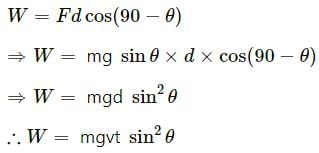
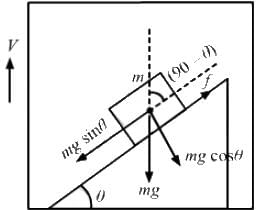
Report a problem
Question for HC Verma Questions and Solutions: Chapter 8- Work & Energy- 1
Try yourself:A block of mass m slides down a smooth vertical circular track. During the motion, the block is in
Explanation
The net force on the block is not zero, therefore the block will not be in any given equilibrium.
Report a problem
Question for HC Verma Questions and Solutions: Chapter 8- Work & Energy- 1
Try yourself:A particle is rotated in a vertical circle by connecting it to a string of length l and keeping the other end of the string fixed. The minimum speed of the particle when the string is horizontal for which the particle will complete the circle is
Explanation
Report a problem
Question for HC Verma Questions and Solutions: Chapter 8- Work & Energy- 1
Try yourself:The total work done on a particle is equal to the change in its kinetic energy
Explanation
According to the work-energy theorem, the total work done on a particle is equal to the change in kinetic energy of the particle.
Report a problem
*Multiple options can be correct
Question for HC Verma Questions and Solutions: Chapter 8- Work & Energy- 1
Try yourself:A particle is acted upon by a force of constant magnitude which is always perpendicular to the velocity of the plane. The motion of the particle takes place in a plane. It follows that
Explanation
When the force on a particle is always perpendicular to its velocity, the work done by the force on the particle is zero, as the angle between the force and velocity is 90° . So, kinetic energy of the particle will remain constant. The force acting perpendicular to the velocity of the particle provides centripetal acceleration that causes the particle to move in a circular path.
Question for HC Verma Questions and Solutions: Chapter 8- Work & Energy- 1
Try yourself:Consider two observers moving with respect to each other at a speed v along a straight line. They observe a bock of mass m moving a distance l on a rough surface. The following quantities will be same as observed by the two observers.
Explanation
Acceleration of the block will be the same to both the observers. The respective kinetic energies of the observers are different, because the block appears to be moving with different velocities to both the observers. Work done by the friction and the total work done on the block are also different to the observers.
Report a problem
*Multiple options can be correct
Question for HC Verma Questions and Solutions: Chapter 8- Work & Energy- 1
Try yourself:You lift a suitcase from the floor and keep it on a table. The work done by you on the suitcase does not depend on
Explanation
Work done by us on the suitcase is equal to the change in potential energy of the suitcase.
i.e., W = mgh
Here, mg is the weight of the suitcase and h is height of the table.
Hence, work done by the conservative (gravitational) force does not depend on the path.
*Multiple options can be correct
Question for HC Verma Questions and Solutions: Chapter 8- Work & Energy- 1
Try yourself:No work is done by a force on an object if
Explanation
No work is done by a force on an object if the force is always perpendicular to its velocity. Acceleration does not always provide the direction of motion, so we cannot say that no work is done by a force on an object if it is always perpendicular to the acceleration. Work done is zero when the displacement is zero.
In a circular motion, force provides the centripetal acceleration. The angle between this force and the displacement is 90° , so work done by the force on an object is zero.
*Multiple options can be correct
Question for HC Verma Questions and Solutions: Chapter 8- Work & Energy- 1
Try yourself:A particle of mass m is attached to a light string of length l, the other end of which is fixed. Initially the string is kept horizontal and the particle is given an upward velocity v. The particle is just able to complete a circle.
Explanation
The string becomes slack when the particle reaches its highest point. This is because at the highest point, the tension in the string is minimum. At this point, potential energy of the particle is maximum, while its kinetic energy is minimum. From the law of conservation of energy, we can see that the particle again passes through the initial position where its potential energy is minimum and its kinetic energy is maximum.
*Multiple options can be correct
Question for HC Verma Questions and Solutions: Chapter 8- Work & Energy- 1
Try yourself:The kinetic energy force on the particle continuously increases with time.
Explanation
Kinetic energy of a particle is directly proportional to the square of its velocity. The resultant force on the particle must be at an angle less than 90° with the velocity all the time so that the velocity or kinetic energy of the particle keeps on increasing.
The kinetic energy is also directly proportional to the square of its momentum, therefore it continuously increases with the increase in momentum of the particle.
*Multiple options can be correct
Question for HC Verma Questions and Solutions: Chapter 8- Work & Energy- 1
Try yourself:One end of a light spring of spring constant k is fixed to a wall and the other end is tied to a block placed on a smooth horizontal surface. In a displacement, the work done by the spring is (1/2)kx2. The possible cases are
Question for HC Verma Questions and Solutions: Chapter 8- Work & Energy- 1
Try yourself:A block of mass M is hanging over a smooth and light pulley through a light string. T he other end of the string is pulled by a constant force F. The kinetic energy of the block increases by 20 J in 1 s.
Explanation
Tension in the string is equal to F, as tension on both sides of a frictionless and massless pulley is the same.
i.e., T – Mg = Ma ⇒ T = Mg + Ma
So, the tension in the string cannot be equal to Mg.
The change in kinetic energy of the block is equal to the work done by gravity.
Hence, the work done by gravity is 20 J in 1 s, while the the work done by the tension force is zero.
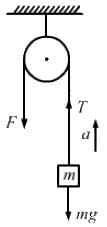
Report a problem

















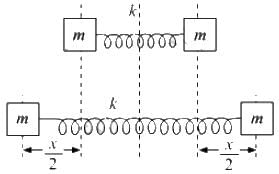


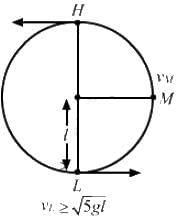

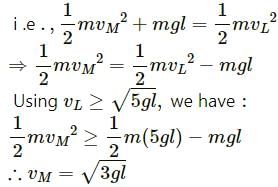
 .
.

















